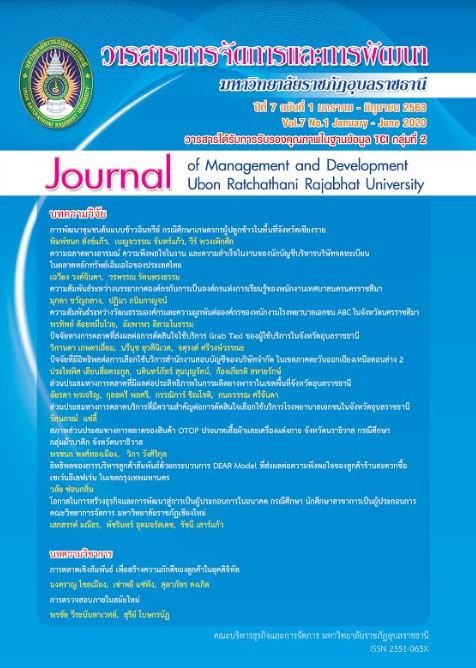การตรวจสอบภายในสมัยใหม่
คำสำคัญ:
การตรวจสอบภายใน, การตรวจสอบภายในสมัยใหม่บทคัดย่อ
การตรวจสอบภายใน คือ กิจกรรมให้ความเชื่อมั่นและการให้คำปรึกษาที่เป็นอิสระ มีวัตถุประสงค์เพื่อเพิ่มมูลค่าและปรับปรุงการดำเนินงานขององค์กร ช่วยให้องค์กรประสบความสำเร็จตามวัตถุประสงค์
ต่าง ๆ ที่กำหนดเพื่อเพิ่มมูลค่าการปรับปรุงประสิทธิผลของกระบวนการบริหารความเสี่ยง การควบคุมและการกำกับดูแลอย่างเป็นระบบระเบียบ การตรวจสอบภายในตามแนวคิดสมัยใหม่ จำแนกเป็นประเภทใหญ่ ๆ ได้ 7 ประเภท คือ การตรวจสอบทางการเงิน การตรวจสอบการปฏิบัติการ การตรวจสอบการบริหาร
การตรวจสอบการปฏิบัติตามข้อกำหนด การตรวจสอบเทคโนโลยีสารสนเทศ การตรวจสอบพิเศษ
และการตรวจสอบอื่น ส่วนองค์ประกอบของการควบคุมภายในตามแนวคิดของ COSO 2013 ประกอบด้วย 5 ประการที่สัมพันธ์กัน ได้แก่ สภาพแวดล้อมของการควบคุม การประเมินความเสี่ยง กิจกรรมการควบคุม สารสนเทศและการสื่อสาร และกิจกรรมติดตาม ดังนั้นองค์ประกอบสำคัญที่จะนำไปใช้ในการศึกษาเกี่ยวกับการตรวจสอบภายในสมัยใหม่ ซึ่งสามารถกำหนดแนวทางได้ สามารถกำหนดตัวแบบที่สำคัญ ได้ 7 ประเด็น คือ 1) การพัฒนางานให้ทันสมัย 2) การตรวจสอบตามผลการประเมินความเสี่ยง 3) การตรวจสอบแบบมีส่วนร่วม 4) การตรวจสอบในเชิงรุกแบบก้าวหน้า 5) การตรวจสอบความชัดเจนของเป้าหมาย 6) การบูรณาการความรู้ตรวจสอบภายใน และ 7) การดำเนินการตรวจสอบภายในที่ดี
เอกสารอ้างอิง
นภดล ร่มโพธิ์. (2554). การวัดผลการปฏิบัติงานองค์กร. กรุงเทพฯ: สำนักพิมพ์มหาวิทยาลัยธรรมศาสตร์.
พิริยาภรณ์ อันทอง และศุภกร เอกชัยไพบูลย์. (2559). Checklist พิชิตธุรกิจยั่งยืน ฉบับ SME. กรุงเทพฯ: ศูนย์รับผิดชอบต่อสังคม ตลาดหลักทรัพย์แห่งประเทศไทย.
อุษณา ภัทรมนตรี. (2555). การตรวจสอบภายในสมัยใหม่ แนวคิดและกรณีศึกษา. กรุงเทพฯ: ภาควิชาบัญชี คณะบริหารธุรกิจ มหาวิทยาลัยเกษตรศาสตร์.
Angelova, B. & Koleva, B. (2015). The Role of Internal Audit in Rink Management System of the Companies. Economic Development/Ekonomiski Razvoj, 17(3), 1-10.
Appelbaum, D., Kogan, A. & Vasarhelyi, M. A. (2017). Big Data and Analytics in the Modern Audit Engagement: Research Needs. Auditing: A Journal of Practice & Theory, 36(4), 1-27.
Baker, L. L. (2016). Integrating Key Risk and Performance Indicators. Internal Auditor, 73(3), 23-27.
Boris, T. (2015). The Influence of the Audit Committee on the Internal Audit Operations in the system of Corporate Governance, Evidence from Croatia. Economic research, Ekonomska istraživanja, 28(1), 187-203.
Breda, S. (2011). Commercial and Professional Audit Goals: Inculcation of Audit Seniors. International Journal of auditing, 1(1), 316-332.
Cecilia, L. K. (2014). The Effect of Participative Budgeting, Budget Goal Clarity and Internal Control Implementation on Managerial Performance. Research Journal of Finance and Accounting, 5(12), 81-87.
Claus, H., Lars B. L. & Seehausen, J. (2012). Establishing Proactive Auditor Responsibilities in Relation to Fraud: the Role of the Courts and Professional Bodies in Denmark. International Journal of Auditing, 16(1), 79-97.
Coetzee, P. & Lubbe, D. (2014). Improving the Efficiency and Effectiveness of Risk-Based Internal Audit Engagements. International Journal of Auditing, 18(2), 115-125.
Dascălu, E. D. & Nasta, L. (2015). Managerial Accountability – A Key Factor in the Implementation of Internal Control Systems. Ovidius University Annals, Series Economic Sciences, 15(2), 229-235.
Dumitrescu, P. A. & Calota, G. (2014). The Importance of Internal Audit in Optimizing Management Processes. Internal Auditing & Risk Management, 9(4), 11-20.
Fortvingler, J. & Szívós, L. (2016). Different Approaches to Fraud Risk Assessment and Their Implications on Audit Planning. Periodica Polytechnica: Social & Management Sciences, 24(2), 102-112.
Fukukawa, H. & Mock, T. J. (2015). Audit Risk Assessments Using Belief Versus Probability.
Acta universitatis danubius: oeconomica, 11(3), 114-125.
Hoy, Z. & Foley, A. (2015). A Structured Approach to Integrating Audits to Create Organizational Efficiencies: Iso 9001 and ISO 27001 Audits. Total Quality Management & Business Excellence, 26(5/6), 690-702.
Lupu, B. M., Neagu, M. L. & Minea, V. (2013). Internal Audit, Risk Detection Tool for Contemporary Arises. Internal Auditing & Risk Management, 8(2), 149-158.
Ma’ayan, Y. & CarmeliInternal, A. (2016). Audits as A Source of Ethical Behavior, Efficiency, and Effectiveness in Work Units. Journal of Business Ethics, 137(2), 347-363.
Marin, N. P., Silvia, M. P. & Maria, D. G. (2017). The Internal Control Management Development Strategy in Romania. Retrieved April 2, 2019 from https://papers.ssrn.com/sol3/cf_dev/AbsByAuth.cfm?per_id=2763609.
Munteanu, C. C. (2015). Audit Risk Assessment in the Light of Current European Regulations. Acta Universitatis Danubius: Oeconomica, 11(3), 114-125.
Poister, T. H. (2010). The Future of Strategic Planning in the Public Sector: Linking Strategic Management and Performance. Public Administration Review, 1(70), 246-254.
Takan, C. (2015). Proactive Internal Audit Strategy and Firm Performance: A Conceptual Framework. Proceedings of the Academy of Accounting and Financial Studies, 20(2), 81-161.
Theodore, J. M., Rajendra P. S. & Arnold, M. W. (2017). Fraud Risk Assessment Using the Fraud Risk Model as A Decision Aid. Journal of Emerging Technologies in Accounting, 14(1), 37-56.
Tušek, B. & Pokrovac, I. (2012). Independence as A Precondition of an Effective Internal Audit Activity. Proceedings of International Conference of the Faculty of Economics Sarajevo (ICES), 114-125.
ไฟล์ประกอบ
เผยแพร่แล้ว
ฉบับ
ประเภทบทความ
สัญญาอนุญาต
บทความที่ตีพิมพ์ในวารสาร เป็นงานเขียนของนักวิจัยหรือนักวิชาการแต่ละท่านโดยเฉพาะ มิใช่ความเห็นและความรับผิดชอบใดๆ ของกองบรรณาธิการวารสารการจัดการและการพัฒนา มหาวิทยาลัยราชภัฏอุบลราชธานี
บทความ ข้อมูล เนื้อหา รูปภาพ ฯลฯ ที่ได้รับการตีพิมพ์ในวารสารฯ ถือเป็นลิขสิทธิ์ของวารสารการจัดการและการพัฒนา มหาวิทยาลัยราชภัฏอุบลราชธานี หากบุคคลหรือหน่วยงานใดต้องการนำทั้งหมดหรือส่วนหนึ่งส่วนใดไปเผยแพร่ต่อหรือเพื่อกระทำการใดๆ จะต้องทำการอ้างอิงมายังวารสาร





